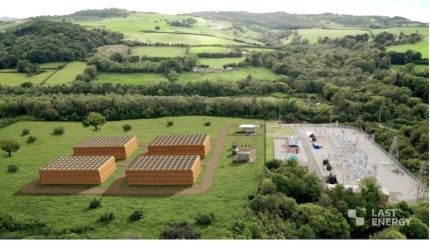
A spokesperson for the UK Office for Nuclear Regulation (ONR) has confirmed that US-based start-up Last Energy has entered the ONR nuclear site licensing process. “We note today’s announcement from Last Energy that it has entered our nuclear site licensing (NSL) process for its plans to develop four 20 MWe microreactors in South Wales,” ONR said.
Last Energy said in October 2024 that it plans to develop privately financed micro modular nuclear power plants at the closed site of the Llynfi coal-fired power station in Bridgend County, South Wales, to serve local industrial customers. As a full-service developer, Last Energy owns and operates its plug-and-play power plant on the customer’s site, bypassing the need for electric transmission grid upgrades. The company relies on existing supply chains and uses traditional pressurised water reactor technology.
In December 2024, the Export-Import Bank of the United States (EXIM) issued Last Energy a $103.7m letter of intent confirming the Bank’s willingness to finance end-to-end delivery of the company’s first microreactor in South Wales. The company obtained site control and in January 2025 accepted a grid connection offer from National Grid Electricity Distribution (NGED) for 22 MWe of export capacity.
Last Energy, founded in 2019, is a spin-off of the Energy Impact Center, a Washington DC-based research institute. Its PWR-20 design – revealed in 2022 – comprises a 20 MWe (60 MWt) single-loop pressurised water reactor (PWR). The design uses standard full-length PWR fuel enriched to 4.95% and closed-cycle air cooling. Power plant modules would be built off-site and assembled in modules. By using ready-made modular components, Last Energy says a reactor could be assembled within 24 months of the final investment decision. The assumed lifetime of the power plant is 42 years.
The Prosiect Egni Glan Llynfi (Llynfi Energy Project) project will deliver power to mid-size manufacturers throughout the region, providing 24/7 baseload power and putting the local economy on a path toward industrial decarbonisation. Last Energy aims to deliver the first plant by 2027, contingent on the licensing and planning processes. The company says it has obtained site control, has begun conducting site surveys, and has initiated the planning process in order to build its plants on the vacant site that housed the Llynfi Power Station from 1951 to 1977.
According to Last Energy, it will not require public funding for the development and estimates an overall capital investment of £300m ($392m) in equipment, services, and other development-related activities. The company plans to source at least 10% of its needs from South Wales suppliers, equivalent to a £30m local economic investment (not including business rates collected by Bridgend County) and at least 100 local full-time jobs.
Last Energy says it has commercial agreements for over 65 units across Europe. In March 2023 it secured purchase agreements (PPAs) for 34 PWR-20 units with four industrial partners in the UK and Poland. Last Energy said the deals, worth $18.9bn in power sales, mark “the largest pipeline of new nuclear power plants under development in the world”.
ONR said: “The licensing process is fundamental in ensuring that prospective licensees of a nuclear site are ready and able to meet their obligations under the nuclear site licence to protect their workforce and the public. Last Energy has been participating in our early regulatory engagement framework since May 2024, which enables applicants to develop their understanding of regulatory processes and expectations early on in their projects.”
ONR inspectors will now provide pre-application advice to Last Energy as it prepares its application for a nuclear site licence. This will inform Last Energy of the regulatory expectations and legal responsibilities of a nuclear site licensee in the UK.
“We are pleased to officially enter site licensing with ONR, as we continue to make tangible progress toward the delivery of our first microreactor in Wales,” said Michael Jenner, CEO of Last Energy UK, a Last Energy subsidiary.
“This is another critical milestone necessary to unlock nuclear power at scale in the UK, which will help meet growing energy demand and alleviate grid restraints. We appreciate ONR’s efforts during early engagement, which has allowed us to accelerate through the process swiftly. We also very much welcome that ONR has applied proportionality during their engagement with us, as this is a critical enabler for realising the benefits of SMRs.”






